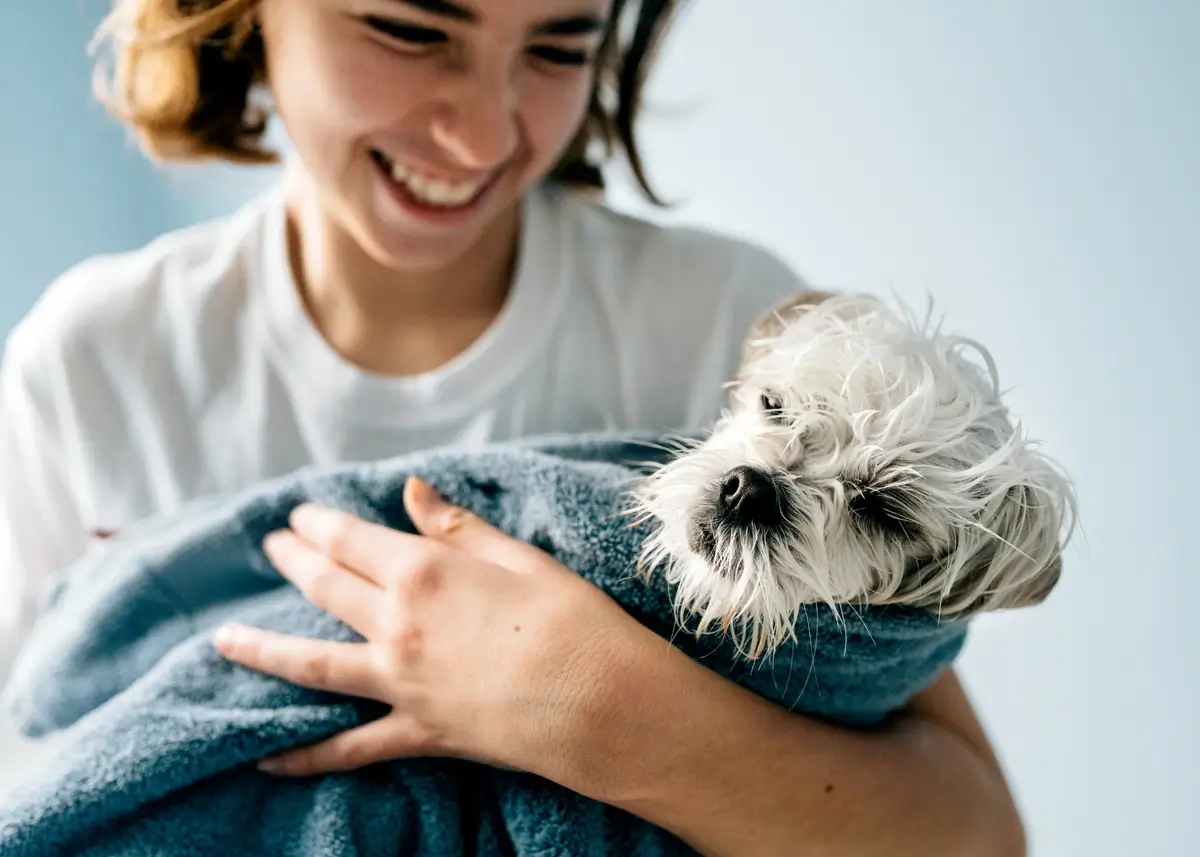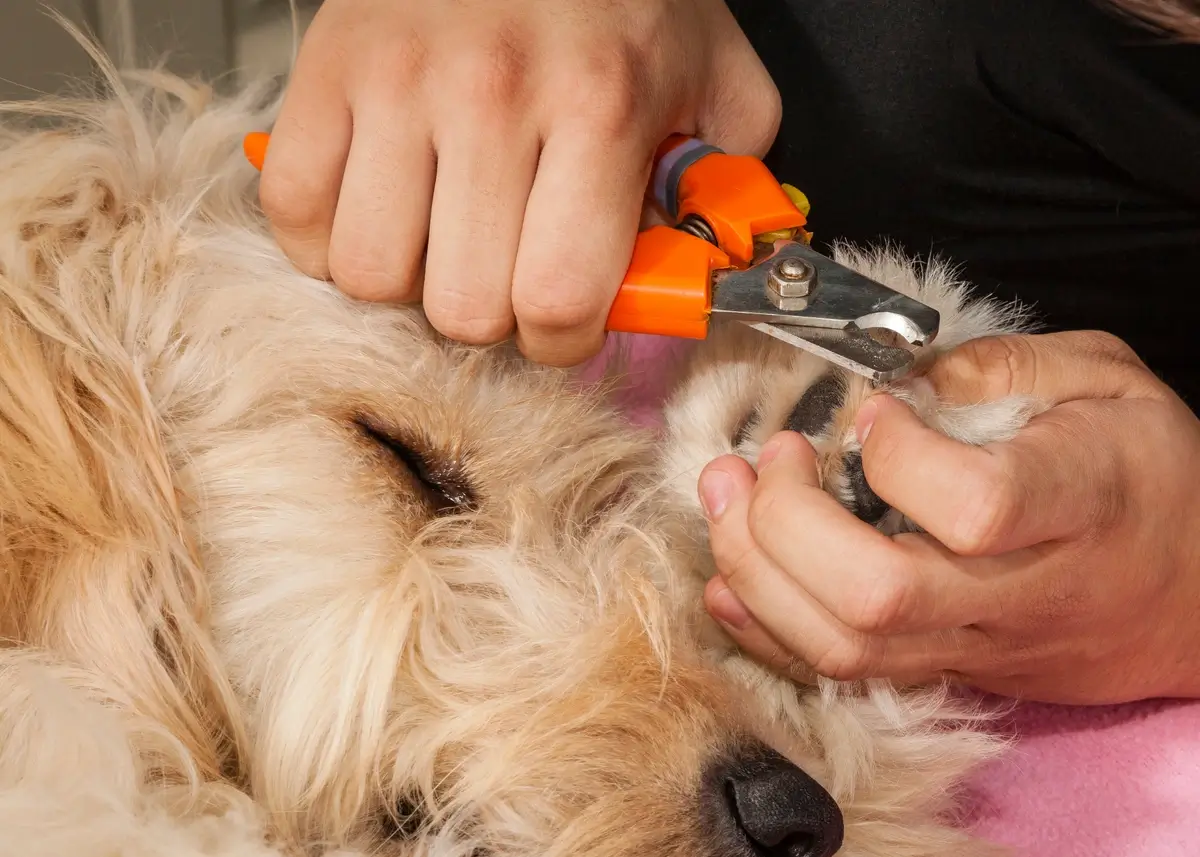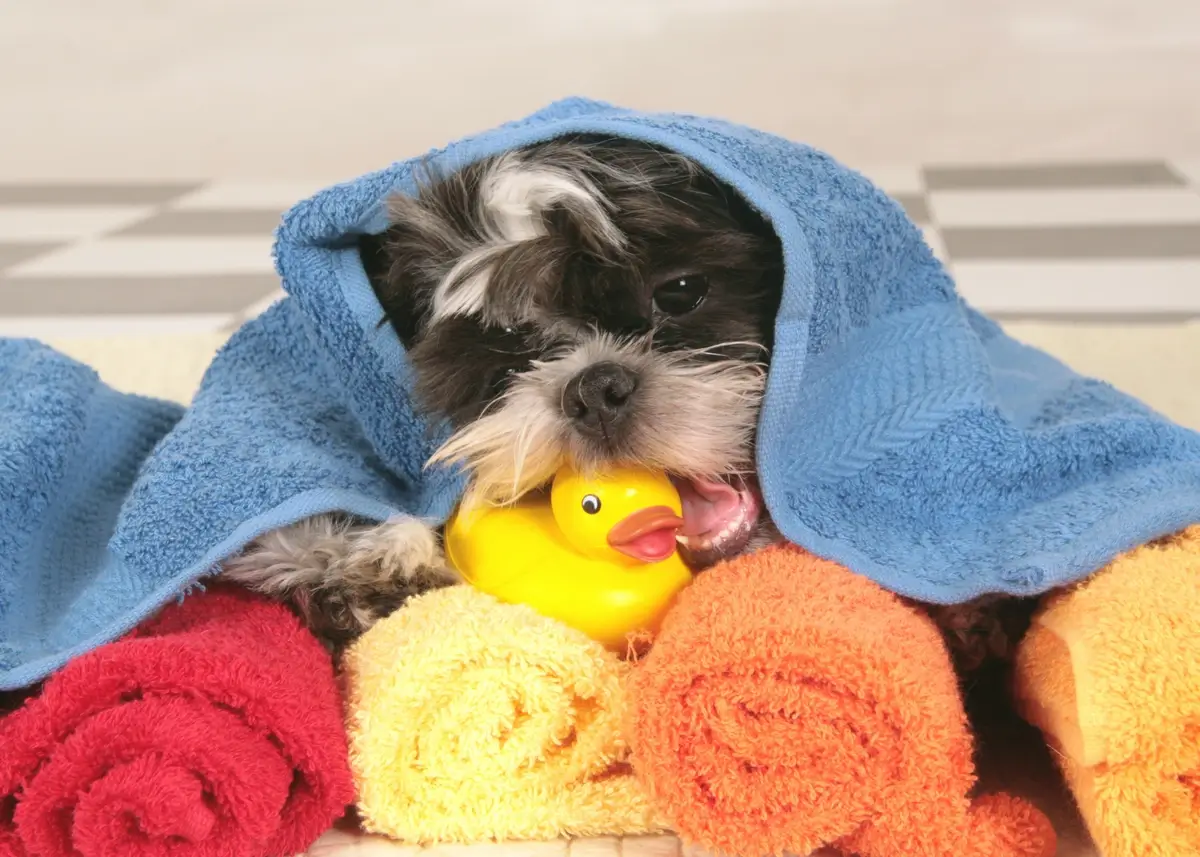One day, you’re minding your business when a stench permeates your nose, just like the wafting, putrid green fumes in a Pepé Le Pew cartoon.
“Pee-ew! What’s that smell? Oh my goodness, why is my puppy so stinky? Where’s my phone – Hello, Groomer? What do you mean there are no more appointments available for 3 months? You don’t understand – my dog smells You mean I can’t just use Febreeze on a dog?”
There will come “that” day in every puppy pawrent’s life when you realize having a puppy isn’t just all fun and games. You’ll be rudely and suddenly initiated into a club no one wants to be a member of – the Smelly Puppy Club! It’s inevitable that they will have an accident, get into some sort of trash, roll around in animal waste, or even get sprayed by a skunk. In these cases, you’ll need to attempt to bathe them and clean them up the best you can. Unexpected dog grooming at home has to happen, whether you know what you’re doing or not!
Beyond just having basic knowledge, you may want to gain a few more skills in learning how to groom your dog so you can be proficient at home. You also may be hesitant to frequent businesses due to health concerns or can’t always make a regularly scheduled appointment.
Learning how to groom your dog at home is a fantastic way to bond with your dog while saving money, keeping your pup healthy, and practicing new skills.
The Importance of Dog Grooming
Poodles and doodle mixes are not the only dogs that need regular grooming – all dogs do! Whether you have a dog with a short, sleek hair coat or a long, silky coat, a single coat or double coat, hypoallergenic hair or rough fur, every dog will need his or her basic grooming requirements to be met for a variety of reasons. There are so many benefits of grooming your dog that are easy to experience. Why not take care of them at home?
Health benefits of grooming for dogs
While you already know that grooming your dog is important, you might not have thought of specific reasons why. When you groom your dog, you gain benefits beyond just your pup looking dapper by improving their health and well-being.
Grooming your dog at home offers several health benefits for dogs while keeping them looking great at the same time.
Monitoring for eye and ear problems in dogs like tear stains, eye infections, discharge, mites, yeast infections, or clogged hair keeps them seeing and hearing well.
Respiratory problems can be detected when you’re checking their nose to see if their breathing is even, raspy, wheezy, or irregular, especially important in snub-nosed breeds known to experience breathing difficulties.
Overgrown nails can cause limping due to uneven pressure and toe & foot deformities.
Mats and dirty coats can harbor filth and parasites, hide painful skin conditions, and add extra weight, affecting musculoskeletal health and contributing to several other health conditions.
Checking for skin conditions can help you identify cuts, irritation, infection, growths, hot spots, or parasites like fleas and ticks.
Dental hygiene problems cause foul breath and much more serious conditions like gingivitis that can lead to heart disease.
Impacted anal glands can cause redness or swelling resulting in anal sac disease.
Humans benefit from grooming dogs at home
While you personally may not come out of the experience with a new haircut, a festive bandana, and little bows in your hair, you can experience lots of positive benefits when you learn how to groom your dog at home.
Strengthen your bond with your dog
Researchers have found the bond that forms between the owner and their dog is similar to the bond that a mother forms with her baby. When you have something you have to care for on a deeper level, you experience the unconditional love a dog has for you, boosting your mood and relieving anxiety and stress. Learning how to groom your dog at home is a way to work on cementing your strong bond and sharing your love with each other.
Never stop learning new things
Learning a new skill like home dog grooming and practicing regularly can give you a sense of accomplishment and keep your brain sharp. When you learn how to groom a dog, you thicken your brain’s prefrontal cortex, creating more pathways to regulate your thoughts, actions, and emotions. You can experience more happiness and self-confidence when you practice your scissors skills.
How to Groom Your Dog at Home: 13 Steps
Step 1: Set the tone
Grooming your dog at home doesn’t have to be a stressful experience, so take a bit of time to set the mood of your grooming space. Put on some calming music or give your dog a special anxiety-reducing treat if needed.
Researchers have found that playing classical music for dogs reduces stress and results in lower respiratory rates, less barking, and lower levels of cortisol, a stress hormone. Slowing down will help you release any tension you are carrying as well and put you in the right headspace – important when you’re about to hold sharp objects!
Step 2 Choose the right grooming tools
Have you ever seen a quilter lock the handles of fabric scissors to prevent someone from using them to cut paper? That’s because fabric scissors are sharper, and using them to cut paper can dull the blade. What about a gardener using a watering can to water the lawn? It’s clear you need to use the right tool for the job.
Knowing which dog grooming tools you need to groom your dog at home will help your grooming session go smoothly. Depending on the size of your dog and its coat type, you may find yourself using all or a few of these tools to groom your puppy at home:
- Dryer
- Combs
- Shears
- Brushes
- Clippers
- Ear powder
- Accessories
- Non-slip mat
- Nail trimmers
- Dental care kit
- Styptic powder
- Wipes & towels
- Deshedding tools
- Warm water source
- Cotton balls or gauze
- Shampoos & conditioners
- Bathing tubs & spray nozzles
Always make sure the tools and supplies you are using are gentle, non-toxic, and pet-friendly. Never use products meant for humans such as toothpaste, lotions, shampoos, or conditioners because the formula and fragrances can potentially harm a dog.
Step 3: Gather and set up supplies
While your music is playing and your puppy’s treat is starting to take effect, gather all the supplies you’ll need and set them up in an ergonomic manner for your session to flow well. You definitely don’t want to be mid-trim and not have the tool you need or get in your own way when trying to reach a comb you didn’t think about prior to starting.
Don’t forget to get your delicious, high-value puppy treats ready. You want to condition your dog to associate a grooming session with lots of treats, praise, and positive attention, not an activity to be feared.
Step 4: Eyes, ears, and nose
Take a damp, wet cloth, cotton ball, or gauze and gently wipe your dog’s eyes. Look for any signs of infection, discharge, or tear staining.
With the same materials, wipe the inside folds of your dog’s ears. Definitely pay attention to any yeasty or stinky smell and any irritation indicating a possible infection. Be sure to clean out the folds really well, and don’t use Q-Tips designed for humans in a dog’s ear.
Certain breeds have hair further down in their ears than others, and you may see some hair that needs to be plucked from their ears. You can use ear powder to prepare the hair, secure the clump of hair with your fingers or a special tool, and pull gently. Stop if you sense any discomfort in your pup.
Lastly, examine your dog’s nose to check for runny discharge, a dry, cracked nose, or any other noticeable variation from the norm.
Step 5: Brush your dog’s pearly whites
Would you like to try out a tube of peanut butter-flavored toothpaste? No? While you may make a face, dogs love specialized dog toothpaste that comes in appealing flavors.
You can use a toothbrush with a handle or a silicone bristled sleeve that fits over your finger. Place some toothpaste on the toothbrush and let your dog lick some to get used to the taste.
Open your dog’s mouth slightly and hold the dog toothbrush with the bristles pointing toward the gumline starting from the back teeth and working your way to the middle teeth. Try to get each tooth for a total of 30 seconds on each side.
Step 6: Brush your dog’s coat
Hopefully, you’re not the kind of person who skips over regular coat maintenance! It’s important to keep your dog brushed to prevent mats, remove loose dirt and oil, and keep their coat shiny in between sessions.
You’ll want to brush your dog before you give them a bath and definitely before their coat gets wet. Starting from the top to the bottom, use gentle but firm, long strokes in the direction of hair growth.
Make sure you’re using the right brush for your dog’s coat type. Dogs with a thick undercoat will need to be thoroughly brushed with a de-shedding tool to remove trapped hairs, while a dog with short, sleek hair might be fine with a rubber brush.
Don’t forget to clean up all the hair before the floor clumps get wet! Cleaning as you go always pays off in the end.
Step 7: Give a pawicure
Now that we’ve covered eyes, ears, nose, mouth, and coat, it’s time to trim your dog’s nails. You’ll know when to trim your dog’s nails when you can hear them clicking across the floor or it’s been about a month since the last trim.
You can use hand-held clippers or a grinding tool to trim nails. Hold their paw firmly with one hand and operate the clipper with the other, using your body to wrap around their body to keep them still. Draw back the nail with your thumb and push one toe out, cutting straight across the nail.
Stop trimming dog nails right above the quick, the area that supplies blood to the nail. If the quick is nicked, nerves can cause pain and bleed, so be sure to pay attention and not over-trim.
If your dog has dewclaws, make sure to trim those, too. Keep a styptic product like Kwik-Stop or a baking soda paste handy to put on the quick to help stop the bleeding.
Step 8: Rub-a-dub-dub
Some people may rank giving a dog a bath as one of the most difficult processes during grooming (alongside trimming and cutting). It will take lots of coaxing, positive rewards, and patience to bathe a dog no matter what the size!
Set up a bath, whether it is your bathtub or a raised grooming tub, to be both comfortable for you and your pup. Using a handheld sprayer, lots of delicious treats, and employing the help of a friend will definitely assist you in making the process easier.
Start by rinsing your puppy from top to bottom with warm water, and thoroughly wetting the coat. Apply shampoo according to the instructions. Lather the shampoo all over your dog’s body, including the ears, armpits sanitary area, and paws.
Thoroughly rinse until the shampoo is out completely. You may want to repeat shampooing again if the coat still doesn’t look and feel clean enough for you.
Next, apply conditioner meant for dogs, leave it on for a few minutes, and rinse. You’re almost done with doggy bath time!
Step 9: Dry your dog
You’ve got a wet dog – now what? You’ll need to dry your dog in some fashion after that last rinsing step. There are pros and cons to both air drying and using a dryer that plugs in.
Drying your dog by hand can be a hilarious occurrence straight out of a comic strip. Even with two people trying to catch him, your dog may get the zoomies and dart around, making it as easy as catching a greased pig to dry him off. Your dog also may shake himself dry before you have a chance to soak up excess water. Be prepared to get wet either way!
When you air dry your dog, you want to make sure fungus doesn’t have a chance to grow in between moist toes and that you take into consideration your breed’s hair type. For example, a short-haired, single-coated dog will not have the same concerns as a doodle mix’s hair matting up when left to air dry.
Using a dryer to dry your dog can also help speed up the drying process and keep the tangles at bay for some breeds. Drying ensures toes and hot spot areas are dry and prevents wild hair cowlicks. Using the lowest setting, alternate between heated and cool air, and never keep the dryer in one place for too long.
Regardless of which method you use to dry your dog, brush your dog again after its coat is completely dry.
Step 10: Assess your attitude and demeanor during the session
Congratulations! You are almost through grooming your dog at home, and you’ve survived bathtime! Now, how are you doing with the process? You may have learned your dog can only tolerate so much or are trying to figure out how not to cut her if she keeps wiggling. Your patience may be hanging by a thread. It’s okay to take a break!
Make sure to keep tabs on your own mood, too. If you are stressed out, your dog is definitely going to pick up that vibe and act accordingly. Stay cool! If your puppy is too wiggly or wound up, cut the session short and try again.
Step 11: Trim the coat
Most people who groom their dogs at home are probably not giving a precision lion cut for a Standard Poodle aiming for Best in Show. You may even be aiming for “good enough!” Before you become Edward Scissorhands, keeping a cut or trim simple is a great way to go when figuring out how to trim a dog yourself.
Never shave a double-coated dog! We promise they aren’t too hot. The air trapped in between the 2 layers helps your dog stay cool or hot depending on the weather, and stripping away the natural protection system can be very uncomfortable for your dog.
Because grooming a dog with clippers at home may be illustrated better visually, here are 3 videos to show you how it’s done.
Picking The Right Clipper Blades For Dogs from Furry Friends Zone
How to Use Dog Clippers to Trim or Cut Dog's Hair (A Quick Method) from Top Dog Tips
How to Cut a Dog's Hair: Basic Grooming Tutorial from AnimalWise
Step 12: Accessorize
This may be your favorite part of grooming – accessorizing your dog! You can make your own bandanas from scrap material or have a bow handy in every color and for every holiday. After you add the finishing touches, spritz your dog with an after-bath spray for that extra fresh, clean scent.
Step 13: Clean up
We’re sorry to tell you that the Cleaning Fairy has been on strike for some time and will not show up to take care of the dog hair, wet towels, and grooming tools that are strewn about. While your dog is enjoying a post-bath activity, whether it is running wild with the zoomies, chomping on a bone for a job well done, or zonking out on his special blanket, take the time to completely clean up. Check your tools to see if they’re in good order, and make sure you dry or oil them if needed. Tuck everything away in an accessible location for next time.
Dog Grooming at Home: When to See a Professional
There are lots of reasons why you may want to contact a professional groomer after trying to groom your dog yourself at home.
Sometimes, we just aren’t comfortable trying to groom our dog at home after all, even after trying tools that are designed to help make the process easier. We’re still proud of you for trying!
If you find anything out of the ordinary that concerns you, it’s definitely time to call either a vet or a groomer to have it looked at. If you find mats you can’t untangle or handle yourself, a groomer will be able to help remove them. If you find an angry hot spot or a strange lump, schedule an appointment with your vet right away before the condition gets worse.
Another reason you may want to visit a groomer is if your dog isn’t cooperating with you at all. While you may have the skills, your dog may disregard all your knowledge and make the session extra difficult. Professional groomers will be able to use their specialized equipment and expertise to get the job done.
Lastly, you may just want to save the nastier jobs for the professionals, as sometimes no amount of money can truly pay for taking care of the grosser parts of grooming. A dog’s anal glands will need to be expressed, and you may not want any mishaps with this foul-smelling substance in your home!
Groom a Pawrade Puppy at Home
Ready to try out your grooming skills on your furry friend? Oh wait – do you need to find a cuddly 4-legged buddy first? Great – we’ve got you covered! Choose one of our puppies for sale to complete your family. Our team members put our experience and expertise to work for you by matching vetted breeders with families like yours looking to adopt a puppy.





